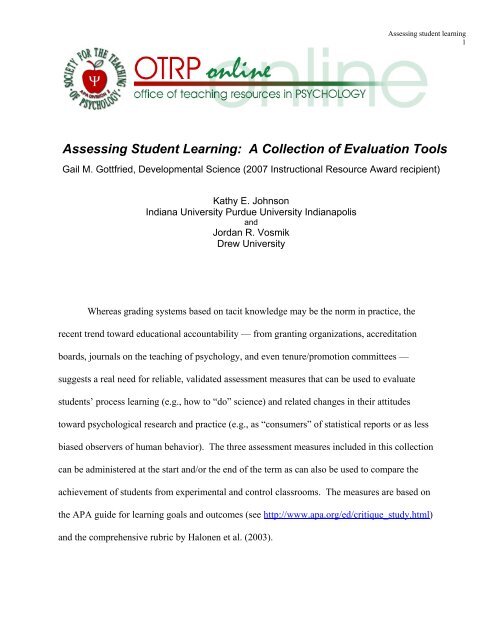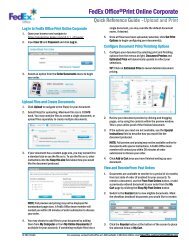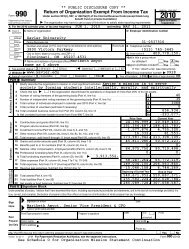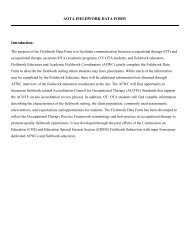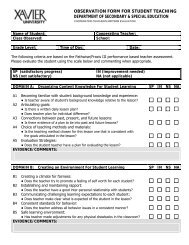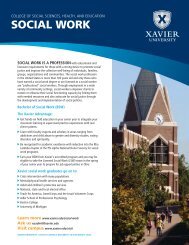Assessing Student Learning: A Collection of Evaluation Tools
Assessing Student Learning: A Collection of Evaluation Tools
Assessing Student Learning: A Collection of Evaluation Tools
You also want an ePaper? Increase the reach of your titles
YUMPU automatically turns print PDFs into web optimized ePapers that Google loves.
<strong>Assessing</strong> student learning1<strong>Assessing</strong> <strong>Student</strong> <strong>Learning</strong>: A <strong>Collection</strong> <strong>of</strong> <strong>Evaluation</strong> <strong>Tools</strong>Gail M. Gottfried, Developmental Science (2007 Instructional Resource Award recipient)Kathy E. JohnsonIndiana University Purdue University IndianapolisandJordan R. VosmikDrew UniversityWhereas grading systems based on tacit knowledge may be the norm in practice, therecent trend toward educational accountability — from granting organizations, accreditationboards, journals on the teaching <strong>of</strong> psychology, and even tenure/promotion committees —suggests a real need for reliable, validated assessment measures that can be used to evaluatestudents’ process learning (e.g., how to “do” science) and related changes in their attitudestoward psychological research and practice (e.g., as “consumers” <strong>of</strong> statistical reports or as lessbiased observers <strong>of</strong> human behavior). The three assessment measures included in this collectioncan be administered at the start and/or the end <strong>of</strong> the term as can also be used to compare theachievement <strong>of</strong> students from experimental and control classrooms. The measures are based onthe APA guide for learning goals and outcomes (see http://www.apa.org/ed/critique_study.html)and the comprehensive rubric by Halonen et al. (2003).
Included in this collection<strong>Assessing</strong> student learning2A Rubric for Evaluating a Psychology Research ReportIntroduction 3Rubric and guidelines for use 12*Evaluating <strong>Student</strong>s’ Process Knowledge:Measuring Understanding <strong>of</strong> Inter-Rater ReliabilityIntroduction 18Activity 20*Scoring rubric 22Reading a Journal Article: An Assessment ToolIntroduction 23Activity 26*Scoring rubric 27*To allow instructors to print the measures directly for classroom use, we have removed the page number and shorttitle from these manuscript pages._____________________________________Author contact information: Gail M. Gottfried, PhD Developmental Science, P.O. Box 1354, Sierra Madre, CA 91025(gailg@devscilabs.com)Copyright 2009 by Gail M. Gottfried. All rights reserved. You may reproduce multiple copies <strong>of</strong> this material for your ownpersonal use, including use in your classes and/or sharing with individual colleagues as long as the authors’ names andinstitutions and the Office <strong>of</strong> Teaching Resources in Psychology heading or other identifying information appear on thedocuments. No other permission is implied or granted to print, copy, reproduce, or distribute additional copies <strong>of</strong> this material.Anyone who wishes to produce copies for purposes other than those specified above must obtain the permission <strong>of</strong> the authors.
<strong>Assessing</strong> student learning3A Rubric for Evaluating a Psychology Research ReportGail M. GottfriedDevelopmental Science (2007 Instructional Resource Award recipient)Jordan R. VosmikDrew UniversityKathy E. JohnsonIndiana University — Purdue University IndianapolisThe APA Guidelines for the Undergraduate Psychology Major (American PsychologicalAssociation, 2007) recommend that students who complete a baccalaureate degree be able to“understand and apply basic research methods in psychology, including research design, dataanalysis, and interpretation” (Goal 2). In addition, the discipline <strong>of</strong> psychology has alwaysvalued effective writing practice, and psychologists have worked hard to elucidate standards forwriting through an evolving editorial style manual (American Psychological Association, 2005).Thus, Goal 7 <strong>of</strong> the APA Guidelines, Communication Skills, includes the following learningobjectives: (a) students should “demonstrate pr<strong>of</strong>essional writing conventions (e.g., grammar,audience awareness, formality) appropriate to purpose and context”; and (b) students should “useAPA style effectively in empirically based reports, literature reviews, and theoretical papers.”Many psychology curricula require an empirical report or literature review as the productby which faculty will assess students’ attainment <strong>of</strong> these goals, likely within a research methodsor experimental psychology course. However, the amount <strong>of</strong> class time dedicated to instruction
<strong>Assessing</strong> student learning4on writing an empirical report can vary dramatically. On many campuses, introductory writingclasses fall exclusively within the domain <strong>of</strong> the English Department, and instructors <strong>of</strong>psychology may consider some aspects <strong>of</strong> student writing (e.g., grammar, spelling) to fall underthe jurisdiction <strong>of</strong> campus writing centers. As a result, students may arrive in upper-divisionpsychology classes with minimal experience with scientific, discipline-specific writing,including little experience reading and critically evaluating published research in psychology.These students may struggle to learn the culture and conventions <strong>of</strong> writing for psychology.Even in classes with direct instruction on APA-style writing, faculty may find the grading<strong>of</strong> empirical reports to be extremely time consuming, particularly when they provide studentswith detailed feedback on the strengths and weaknesses <strong>of</strong> their writing (see Willingham, 1990,for discussion <strong>of</strong> the importance <strong>of</strong> such feedback). Additionally, faculty may feel hampered bythe lack <strong>of</strong> objective criteria for evaluating the content <strong>of</strong> the report, especially in an area inwhich they may not be well versed in the literature (e.g., senior theses or other independentprojects).We address some <strong>of</strong> these concerns with the creation <strong>of</strong> an analytical scoring rubric foran empirical report. A rubric is an explicit expression <strong>of</strong> the performance criteria for a particularproduct, in combination with detailed criteria for levels <strong>of</strong> mastery, expressed along a continuum.It describes what excellent performance should be like, and also shows what developing andpoor performance will look like—with as many gradations as seem useful or appropriate.Analytic scoring rubrics are especially helpful when the product or behavior being assessed iscomplex because they provide the structure for assessment <strong>of</strong> separate aspects <strong>of</strong> performance(Brookhart, 1999).
In this introduction, we present the procedures we followed, and the challenges weencountered, in the development <strong>of</strong> an objective, standardized rubric for evaluating studentresearch projects. Following the introduction is the rubric itself, with general guidelines for itsuse.<strong>Assessing</strong> student learning5Rubric developmentThis project began with a request for “grading systems/rubrics that faculty use for scoringstudents’ experimental projects (complete APA style paper, proposal, oral presentation, or fullliterature review with hypothesis)” sent by GMG (first author <strong>of</strong> this paper) to the CognitiveDevelopment Society Listserv. This request yielded responses from 21 faculty and graduatestudent instructors from the United States and Canada. Most included a checklist <strong>of</strong> evaluationcriteria or items to be included, with a total point value (e.g., “literature review thorough andlogically organized? out <strong>of</strong> 10 [points]”; see Mertler, 2001, for a discussion <strong>of</strong> the distinctionbetween checklists and rubrics), but did not include any information about the types <strong>of</strong> answersthat merited any given point value (e.g., how does a literature review that earns a score <strong>of</strong>10differ from one that earns a score <strong>of</strong> 9, and what would be included or omitted in a literaturereview that earns a score <strong>of</strong> 1 or 2?). From these samples (i.e., content-related evidence; seeMoskal & Leydens, 2000) and from discussion at the 2007 Developmental Science TeachingWorkshop (Gottfried, 2007), we compiled an overall list <strong>of</strong> key content issues to be included inour rubric.One faculty member, JRV (second author <strong>of</strong> this measure), responded to the initial emailrequest with a fully developed rubric for an empirical paper. Her rubric included eight gradedsections (i.e., Abstract; Introduction — Context and Literature Review; Introduction —
Literature Advancement; Introduction — Hypothesis; Method; Results; Discussion; andScientific Writing Style), which could be scored as meeting one <strong>of</strong> three well-definedachievement levels: Exceptional (4 points); Effective to Less Effective (3 or 2 points); andUnsatisfactory (1 or 0 points). Additionally, each section was weighted: The Abstract, forexample, was weighted x2, so that an exceptional abstract earned 8 pts (2 x 4).Working together and assisted by the participants in the 2007 Developmental Science<strong>Assessing</strong> student learning6Teaching Workshop, the three authors <strong>of</strong> this measure (GMG, JRV, and KEJ) then modified thisrubric, adding content from the other examples and emphasizing the pr<strong>of</strong>iciency levelsarticulated in Halonen et al.’s (2003) paper on assessing scientific inquiry in psychology. First,we identified three distinct areas <strong>of</strong> focus: research skills (i.e., descriptive, conceptualization,and problem solving skills domains, including the presentation <strong>of</strong> a theoretically ormethodologically interesting hypothesis, a clean design, and appropriate analytical tools);communication skills (i.e., the content and clarity <strong>of</strong> the written report, including selection <strong>of</strong>relevant and current empirical articles presented in an organized and clear theoretical framework),and the use <strong>of</strong> APA style and formatting. We then expanded the topic list to address 16 distinctcomponents <strong>of</strong> an empirical paper. Divisions beyond the original 8 were primarily in the methodsection (e.g., separately evaluating participants, materials, procedure, and design) and regardingwriting style and APA formatting.Next, to differentiate among “Effective” and “Less Effective” responses, we added afourth pr<strong>of</strong>iciency level. Our new rubric thus included Advanced, Effective/Developing, Lesseffective/Introductory, and Poor categories. Importantly, we used a criterion-referenced, ratherthan a norm-referenced, approach to assessment: Our Advanced level <strong>of</strong> performance was notequated with earning an A but rather with the highest standard <strong>of</strong> the field <strong>of</strong> psychology. The
criterion is authentic in that it is similar to the standards used by editors in evaluating a<strong>Assessing</strong> student learning7submission for publication. Note that our choice in setting such a high standard was multifold:First, we wanted to ensure that students recognized the characteristics <strong>of</strong> work at the highestlevel. This understanding is especially useful for students who aspire to attend graduate schoolin a research-based field but perhaps can also motivate students to strive toward higher goals.Second, we wanted to ensure that all undergraduate students, and perhaps early graduate students,would be clearly represented across the scale. Third, we wanted to be able to use the same rubricto evaluate individual students’ growth across a curriculum, perhaps as part <strong>of</strong> portfolioassessment. A standardized rubric can capture development over time in a way that gradescannot. For example, a student in a 200-level methods class may write a Discussion that restatesresults and mentions possible confounds, thus meeting the learning objective for that course andearning an A. However, if the student were to present the same Discussion for a 400-level seniorcapstone class, he or she would likely not meet the learning objective for the upper-divisioncourse, which may focus on synthesis, evaluation, and theory rather than methodologicalconfounds. An objective comparison at two points <strong>of</strong> time, based on the same evaluative criteria,provides data from which to infer learning. Fourth, while recognizing that grade assignment,curricular expectations, and skill level <strong>of</strong> the students differ at every institution, we wanted toensure the rubric could be used across institutions, based on the same standards. Suchstandardization would allow the rubric to be used as a research tool — an objective measure <strong>of</strong>student learning before and after introduction <strong>of</strong> a new teaching technique or program, forexample, or to compare treatment and control classes.Finally, we removed the specific values for the weights <strong>of</strong> each section, recognizing thatfaculty may choose different weights based on the focus <strong>of</strong> their classes. We note, however, that
that faculty using the rubric should assign weighted point values to each section when grading,based on their own course expectations and goals.Reliability<strong>Assessing</strong> student learning8We then tested the reliability <strong>of</strong> the rubric. We collected eight research papers from ourundergraduate students, who agreed to let us use their papers for this project 1 . We includedsenior theses, senior capstone projects, and empirical papers for a junior-level research methodsclass. At least two <strong>of</strong> us scored each paper using the rubric; we then computed pairwise percentagreement as a measure <strong>of</strong> interrater reliability. To our surprise, our reliability ranged from 37%to 56%. Our follow-up discussions and reflection on content validity led to another revision <strong>of</strong>the rubric to include 18 topical categories and more clearly operationalized research skills. Wealso more clearly differentiated among research skills and communication skills. GMG and KEJthen scored two additional papers, but our inter-rater reliability was still under 70%.Though our attempts to establish high inter-rater reliability using our revised criteria andmore detailed rubric ultimately failed, we believe that the rubric itself is an important asset tostudent learning and more effective teaching. We also believe that our challenges introduce anumber <strong>of</strong> interesting research questions. Thus, rather than revise the rubric again, we havechosen to present it in its current version, with several suggestions for its use.Using the rubric: Advice to fellow facultyFirst, we strongly believe that a carefully constructed, richly detailed rubric can beeffective when it comes to helping students to write better research papers, perhaps even moreeffective than textbook chapters devoted to research writing in psychology. Rubrics explicitlydraw contrasts between more and less effective means <strong>of</strong> conveying scientific ideas through the1 We did not request student permission to reprint their responses; thus, we have not included sample reports and thescores we gave to them.
process <strong>of</strong> writing. They also provide students with normative information concerning what’stypically expected at their current level <strong>of</strong> pr<strong>of</strong>iciency, and with how they might change their<strong>Assessing</strong> student learning9writing to attain the next level <strong>of</strong> competency. The framework for the rubric provides a checklist<strong>of</strong> sorts to ensure that students include the content that is expected, and the anchors aligned withvarying levels <strong>of</strong> competency enable students to understand exactly what is expected <strong>of</strong> them inthe particular course that they are taking. Thus, we believe that the rubric should be shared withstudents early in the semester and that time should be invested in making sure that the content iswell understood. A good strategy for facilitating this comprehension is peer evaluation — werecommend that students be granted the opportunity to read sections <strong>of</strong> their peers’ papers inclass and to provide feedback to each other using relevant sections <strong>of</strong> the rubric. One <strong>of</strong> us (KEJ)engaged in this activity with groups <strong>of</strong> students writing honors theses, and students commentedthat the peer evaluations had very much helped them to reflect upon their own writing and theways that it could be improved. Other possible learning experiences include using the rubric toevaluate published journal articles, student-written articles published by Psi Chi, or departmentalhonors theses from previous years.Second, the rubric (particularly after it has been used for a semester or two) cuts downsignificantly on the amount <strong>of</strong> time that instructors must spend providing feedback to students ontheir writing. At the same time, the quality <strong>of</strong> the feedback almost certainly improves, as studentscan readily see areas that are relative strengths and weaknesses. Ultimately using the rubric forevaluation may allow instructors to take the time to provide feedback on multiple drafts <strong>of</strong> thesame paper, a practice that almost certainly will lead to greater improvement in student writingthan the standard practice <strong>of</strong> collecting a paper toward the end <strong>of</strong> the semester and providingfeedback only after the grading period has ended.
The most challenging aspect <strong>of</strong> using a rubric effectively is calibrating the ratings <strong>of</strong>multiple instructors (or a single instructor and multiple teaching assistants) so that there issufficiently high inter-grader reliability. We suggest that such agreement may be far easier toobtain within departments than across departments from different universities. Our efforts to<strong>Assessing</strong> student learning10achieve similar ratings during our development <strong>of</strong> the rubric were generally unsuccessful. Yet wewere reading papers that we had not assigned, by students that we had not met and who attendeduniversities that we had never visited. It is likely that departmental cultures and the missions <strong>of</strong>the institutions in which they reside (whether urban comprehensive institutions, researchextensiveuniversities, liberal arts colleges, or community colleges) shape the criteria that facultyuse to gauge levels <strong>of</strong> pr<strong>of</strong>iciency with writing. Additionally, individual faculty come to the taskwith their own writing experiences, pr<strong>of</strong>iciency levels, and preferences (e.g., JRV still prefers heroriginal 3-item evaluation scale, rather than the modified 4-item scale we created). Instructorratings can also be affected by the idiosyncratic histories <strong>of</strong> individual students. We may be a bitmore lenient, for example, when a student who has struggled mightily produces a reasonablycoherent piece <strong>of</strong> written work. An honors thesis mentee who is headed for graduate school maybe evaluated more negatively because we are attempting to instill writing habits that mayultimately make the process <strong>of</strong> writing a thesis or dissertation more manageable. We view thebases for inter-grader reliability (or the lack there<strong>of</strong>) to be a highly interesting topic for futureinvestigations, ideally involving collaborations among instructors from a wide variety <strong>of</strong>institutions. We hope that the rubric we have presented here will provide a helpful tool forcarrying out this type <strong>of</strong> research as well as a productive starting point for departmentaldiscussions <strong>of</strong> learning objectives across the curriculum.
<strong>Assessing</strong> student learning11ReferencesAmerican Psychological Association. (2007). APA guidelines for the undergraduate psychologymajor. Washington, DC: Author. Retrieved from www.apa.org/ed/resources.htmlAmerican Psychological Association. (2005). Publication manual <strong>of</strong> the American PsychologicalAssociation. Washington, DC: Author.Brookhart, S. M. (1999). The art and science <strong>of</strong> classroom assessment: The missing part <strong>of</strong>pedagogy. ASHE-ERIC Higher Education Report, 27(1). Washington, DC: The GeorgeWashington University, Graduate School <strong>of</strong> Education and Human Development.Gottfried, G. M. (2007, June). Teaching workshop: Teaching developmental science. SantaMonica, CA.Halonen, J., Bosack, T., Clay, S., McCarthy, M., Dunn, D. S., Hill, IV G. W., et al. (2003). Arubric for learning, teaching, and assessing scientific inquiry in psychology. Teaching <strong>of</strong>Psychology, 30, 196–208.Mertler, C. A. (2001). Designing scoring rubrics for your classroom. Practical Assessment,Research & <strong>Evaluation</strong>, 7(25). Retrieved July 14, 2008 fromhttp://PAREonline.net/getvn.asp?v=7&n=25 .Moskal, B. M., & Leydens, J.A. (2000). Scoring rubric development: Validity and reliability.Practical Assessment, Research & <strong>Evaluation</strong>, 7(10). Retrieved November 28, 2007 fromhttp://PAREonline.net/getvn.asp?v=7&n=10 .Willingham, D. B. (1990). Effective feedback on written assignments. Teaching <strong>of</strong> Psychology,17, 10–13.
EVALUATING A PSYCHOLOGY RESEARCH REPORTA rubric and scoring systemOriginal framework provided by Dr. Jordan Vosmik; revised by G. Gottfried, J. Vosmik, and K. Johnson.Changes and additions based on scoring systems provided by 21 grad student and faculty member volunteerscontacted through the Cognitive Development Society electronic mailing list and Developmental Science pilottesters. Support for the development <strong>of</strong> the rubric was provided by an Instructional Research Award from OTRP.Notes on rubric use:– The system is designed for projects that have an APA-style empirical paper (or components<strong>of</strong> a paper) as an assessment <strong>of</strong> student learning but can be adjusted for posters as needed.We recommend evaluating the title page and the abstract after reading and evaluating the rest<strong>of</strong> the paper/poster.– Content and form are generally scored separately. For example, inclusion <strong>of</strong> tables is scoredwith Results; formatting <strong>of</strong> tables is scored along with APA style. An exception is forscoring the title page.– Content can be reviewed even in the absence <strong>of</strong> a formal subsection. For example, a review<strong>of</strong> the study design does not require a distinct Design subsection in the manuscript; rather,information about the overall design <strong>of</strong> the study should be apparent from the hypothesis andthe Method section. Data reduction may be included in Procedure or in Results. Note thatstudents may include relevant information but in the wrong section (e.g., discuss materials inthe procedure section). Score the content as if it were in the proper subsection (i.e.,description <strong>of</strong> the materials), and mark the organizational problem when scoring form (i.e.,APA style and/or scientific writing style, as appropriate).– Not all sections will be required or emphasized for all projects; certain sections can beomitted or weighted to reflect the particulars <strong>of</strong> the class.– The Advanced criteria in this system should not be equated with earning an A but rather withthe highest standard <strong>of</strong> the field <strong>of</strong> psychology. Some classes may have (and may expect) nostudents producing advanced work in a particular category (e.g., design a study inIntroductory Psychology). Note that an absolute standard such as this allows comparisonsacross developmental levels in a curriculum as well as across institutions.– It is assumed that students who submit something will earn at least one point, with zeropoints being reserved for students who do not submit that particular element, if required.Please address comments and suggestions to Gail Gottfried, gailg@devscilabs.com.
Topic Advanced (4) Effective/Developing (3 points) Less Effective/Introductory (2points)Poor (1 pt)Title pageTitle includes variables and somearticulation <strong>of</strong> relations (e.g.,“difference between…”; “effects <strong>of</strong>x on y”). Running head shortenedbut complete within character limit.All relevant parts <strong>of</strong> the title pageare included. APA style iscompletely correct.All relevant parts <strong>of</strong> the title pageare included. Title/RH isappropriate but may not be veryconcise.Title/RH does not effectively conveyall the variables in the study. Someneeded elements may be missing.Title/RH is not appropriate for ascientific paper. Title page does notfollow APA style.AbstractAbstract includes research question,variables, number and type <strong>of</strong>participants, major results, andimplications/limitations <strong>of</strong> thoseresults stated clearly and conciselywithin the word limit.Abstract includes all essentialinformation but is misleading due toa lack <strong>of</strong> concise sentence structure,or there may be some informationmissing (one paper section).Abstract is missing essentialinformation from two paper sectionsor is significantly over the wordlimit.Abstract has some incorrectinformation or does not accuratelyportray the experiment. Three ormore important elements aremissing.Introduction:Topic & ContextPaper (i.e., first paragraph or two)begins in a broad manner and clearlyexplains the problem to be investigated.Appropriate topic in leveland in content (e.g., thesis makesnovel contribution to field; cognitivedevelopment courses focus oncognitive issues, etc.).Paper starts somewhat broadly, andprovides some theoretical or realworldcontext for the main conceptin the study. An explanation <strong>of</strong> thekey concept or question is provided,but it could be clearer. The topic isappropriate for the class but notnecessarily novel in the field.More clarity in the opening may beneeded or the paper may begin witha definition <strong>of</strong> the topic but providevery little context for the idea (e.g.,may begin immediately with review<strong>of</strong> previous research). The topic,while generally appropriate for theclass, may be simplistic.Paper focuses immediately on themethod, or no context for the topic isprovided. The topic is notappropriate or is overly simplisticfor the class level.Introduction:Literature reviewStudies are described in enoughdetail so that their relation to otherstudies and to the relevanttheoretical and methodologicalissues can be understood by thereader. It is clear whether eachgeneral statement is a hypothesis, aresult <strong>of</strong> a specific study, or ageneral conclusion. The review is inthe author’s own words, and thefocus is on the research, rather thanthe researchers. Limitations <strong>of</strong> priorresearch and contrastingviews/positions are presented.Studies are generally described inenough detail so that their relation toother studies and to the relevanttheoretical and methodologicalissues can be understood by thereader (although some sectionscould be more specific). It is usuallyclear whether each general statementis a hypothesis, a result <strong>of</strong> a specificstudy, or a general conclusion(though some statements may needclarification). The review mayinclude unnecessary quotations orpoor paraphrases <strong>of</strong> the originalarticles.Some <strong>of</strong> the reviewed literatureseems to be inappropriate or notwell-linked to the topic. Literaturemay not be reviewed in enoughdetail for the reader to be sure <strong>of</strong> itsrelation to other studies or to therelevant theoretical ormethodological issues or it may beone-sided, omitting contrastingviewpoints. The review may discusskey concepts from the literaturewithout paraphrasing adequately(i.e., over-reliance on quotations).Too few citations are included forthe reader to be confident that thatliterature has been adequatelyreviewed. Much <strong>of</strong> the reviewedliterature may be inappropriate ornot reviewed in enough detail for thereader to be sure <strong>of</strong> its relation toother studies or to the relevanttheoretical or methodological issues.Definition or discussion <strong>of</strong> keyconcepts may be improperlyparaphrased.
Introduction:LiteratureAdvancementA brief summary <strong>of</strong> the literature isprovided, and there is a specific,clear description <strong>of</strong> what is missingfrom this literature or whatresearchers do not yet know. A clearexplanation <strong>of</strong> how the proposedstudy will answer this question orfill this research gap is included.Specific issues, variables,populations, or methods arementioned.A brief summary <strong>of</strong> the literature isprovided, but the description <strong>of</strong> whatis missing from this literature orwhat researchers do not yet knowcould be stated more clearly. Anexplanation <strong>of</strong> how the proposedstudy will answer this question orfill this research gap is included, butit could be more specific; or, theauthor makes a vague call for moreresearch without specifyingvariables, populations, or methods.A brief summary <strong>of</strong> the literature isnot provided. The description <strong>of</strong>what is missing from this literatureor what researchers do not yet knowis unclear. There is littlejustification why the proposed studywill be important to this literature, orthe author makes a vague call formore research without anyspecificity.A brief summary <strong>of</strong> the literature isnot provided. The description <strong>of</strong>what is missing from this literatureor what researchers do not yet knowis absent or very unclear. There is nodiscussion <strong>of</strong> why the proposedstudy will be important to thisliterature, or no study is proposed atthis point.Introduction:HypothesisHypotheses are all clearly stated,and directional predictions are madebased on the previous literature.They are testable. It is clear whatthe experimental groups will be andwhat will be measured.Main hypotheses are stated clearlyand directional predictions aremade, but it is somewhat unclearwhat the experimental groups willbe or what will be measured. It maybe unclear how the hypothesis linksto the literature.Variables in the main hypothesis arestated, but no directional predictionabout the relation between thevariables is specifically stated. It isunclear what the experimentalgroups will be and what will bemeasured. A hypothesis with nojustification may be included.Direction <strong>of</strong> hypothesis does notfollow from the literature presented.DesignThe design <strong>of</strong> the study is clear andcomplete and appropriate to test thehypothesis. Variables areappropriate and operationalizedproperly.Design is complete and appropriatebut not clearly described.Variables are appropriatelyoperationalized but may besimplistic.Design is not complete or theoperationalization <strong>of</strong> the variables isnot clear. Measured variables maybe simplistic or lack content validity(i.e., not appropriate).Design is not appropriate for thehypothesis; variables are notoperationalized or not valid.Method:ParticipantsSample is appropriate givenhypotheses and large enough forpower. Participant informationincludes number and all necessarycharacteristics. Exclusions based onbehavior (e.g., fussiness, failure tocomplete) are noted, as are anyrecruitment criteria or specialarrangements (e.g., compensation).Sample is appropriate givenhypotheses, although may be small.A relevant characteristic <strong>of</strong> theparticipants may be missing fromthe description. Must includerecruitment criteria or specialarrangements.Sample is not complete givenhypotheses (e.g., wrong ages) but iswell described. Does not includeeither recruitment criteria orexclusion information.Sample is not complete given thehypotheses. Participants are poorlydescribed; replication would not bepossible.
Method:MaterialsMaterials are appropriate givenhypotheses and pilot tested and/orchecked for reliability. Materials aredescribed with enough detail that areader could replicate the study;materials should be appended if selfcreated,cited if not.Materials are appropriate but notcomplete (e.g., too few questions) ornot checked for reliability. Thedescription is adequate but could usemore detail. The measures areappended or cited, as needed.Materials are incomplete and notchecked for reliability, or they lackvalidity given the hypothesis. Theymay also be adequate but simplisticgiven the study goals. Thedescription is lacking in details butthe measures are appended or cited,as needed.Materials are incomplete and lackingin validity. They are not fullydescribed or included in anappendix.Method:ProcedureProcedure is appropriate and ethical.It is described, in order, with enoughdetail that a reader could replicatethe study; instructions and protocolare included. Condition assignmentsare clear; randomization andcounterbalancing are explained asnecessary.Procedure is appropriate and ethical.The description is primarilycomplete but some minor detailsmay be missing, or some proceduralaspects could be explained moreclearly.Procedure is appropriate and ethical.The description is not in order ordifficult to follow, or a few majordetails are absent.Procedure is not appropriate or notethical. The description is unclear,or many major details are absent.Data reductionMeasurement <strong>of</strong> the dependentvariable (i.e., scoring, quantification)is clear, and any procedures fordata treatment are explained (e.g.,reverse scoring is discussed ifnecessary; procedures for datacleaning or handling outliers arepresented). If necessary, a codingscheme is clear and appropriate andinterrater reliability is computed.Measurement <strong>of</strong> the dependentvariable (i.e., scoring,quantification) is clear and/or thecoding scheme is appropriate. Datacleaning and outliers may not bediscussed, or the discussion is notclear. Interrater reliability may nothave been addressed.Measurement if the dependentvariable is appropriate but notexplained clearly and/or the codingscheme is somewhat vague or doesnot cover all response possibilities(e.g., “maybe” in a Y/N task).The scoring/quantification <strong>of</strong> thedependent variable and/or the codingscheme is not appropriate for thedesign <strong>of</strong> the study. It may bedifficult to understand, even fromthe Results, how the data werescored/reduced.Results:DescriptiveStatisticsStatistics are appropriate (e.g.,means and SD; frequency) andcomputed accurately. Tables andfigures are correct, organized byrelevant variables, and called out intext.Statistics are appropriate andcomputed accurately. The figures ortables may have minor errors orconfusing aspects.Statistics are appropriate but may bemissing some relevant information(e.g., means but no SD). Figures ortables are redundant with text oromitted when necessary.Statistics are inappropriate (e.g.,means computed on categoricaldata) or computed inaccurately.Figures or tables are omitted whennecessary.Results:InferentialStatisticsInferential analysis is appropriate foraddressing each hypothesis. Eachfinding is stated in “plain English”and supported with statistics in APAformat.Results section includes correctlyused inferential statistics, but theymay be incomplete (e.g., lackingappropriate post hoc tests) or thefindings are unclear. Results maynot be linked to hypotheses.Results section includes inferentialstatistics, but they may be incorrector incomplete. Results do not seemlinked with the hypothesis <strong>of</strong> thestudy.Overall the inferential statistics donot address the hypotheses <strong>of</strong> thestudy. Results are reportedincorrectly, the wrong test is used, orsome critical information is missing.
Discussion:InterpretationDiscussion includes a restatement <strong>of</strong>the findings. Patterns in the data andrelations among the variables areexplained and conclusions do not gobeyond the data. The explanation/interpretation is well connected tothe hypotheses and to the broaderpsychological problem asrepresented in the introduction. Anydiscrepancies between the expectedresults and the actual data areexplained. The take-home messageis clearly summarized at the end.Discussion includes a restatement <strong>of</strong>the findings, but the analysis <strong>of</strong> theirmeaning may be weak or not wellconnected to the hypothesis. Theremay be lack <strong>of</strong> consideration for thebroader psychological problem.Only some results are explained(esp. only positive), or the links toprevious literature simply restate theintroduction.The restatement <strong>of</strong> the results is notclear or is misleading. Only someresults are explained (esp. onlypositive), and the links to previousliterature simply restate theintroduction. The author mayinappropriately generalize beyondthe data.Discussion incorrectly states theresults or is a rehash <strong>of</strong> theintroduction without clearlypresenting the current study. Thetake-home message <strong>of</strong> the study isnot clear.Discussion:<strong>Evaluation</strong>Author has considered to whatextent the results are conclusive andcan be generalized. Potentialconfounds or methodological limitsare discussed as appropriate, andfuture research is suggested.Potential confounds ormethodological limits are discussedas appropriate, and future research issuggested. Author has notconsidered to what extent the resultsare conclusive and can begeneralized.Potential confounds ormethodological limits are listed butnot clearly discussed, and futureresearch is not suggested. Authorhas not considered to what extent theresults are conclusive and can begeneralized.Potential confounds andmethodological limits may be listedbut may be inaccurate, incomplete,or very unclear.ReferencesReference page includes all and onlycited articles. The articles areappropriately scholarly andappropriate to the topic. Sufficientrecent sources make the reviewcurrent, and classic studies areincluded if applicable and available.Original articles/chapters wereclearly read by the student.Reference list may leave out somecited article or include one that wasnot cited. The articles areappropriately scholarly but may besomewhat tangential and were likelyread by the student. Sources includea good mix <strong>of</strong> recent and classic, asnecessary.Some references may not beappropriate for the assignment. Keyreferences are clearly cited fromother sources and not likely read bythe student. Sources do not include agood mix <strong>of</strong> recent and classic, ifnecessary.Reference list is more like abibliography <strong>of</strong> related sources.References may not be scholarlysources or otherwise not appropriatefor the assignment (e.g., too manysecondary sources), or they may notbe current.
Topic Advanced (4) Effective/Developing (3 points) Less Effective/Introductory (2points)Poor (1 pt)Scientific WritingStyleThere is a clear organization to thepaper, and transitions are smoothand effective. Tone isappropriately formal. Topicsentences are appropriate forparagraphs, and key ideas areexplained/described as needed.Punctuation and grammar arealmost completely correct,including proper tenses and voice.Sentences are concise and wordchoice is precise, with nonbiasedlanguage. Proper paraphrases areusually used, but quotation marksare used appropriately if necessary.Organization is effective althoughimprovements could be made.Transitions are generally there, butare occasionally not smooth, andparagraphs may stray from thecentral idea. Tone is appropriatelyformal. Punctuation and grammarare almost completely correct.Sentences are generally conciseand word choice is usually precise.Paraphrases are usually used, andquotation marks are usedappropriately if necessary.Organization is less adequate,making the paper difficult t<strong>of</strong>ollow. Transitions are sometimesthere, and those that are therecould be improved. Tone isoccasionally colloquial.Punctuation and grammar areusually correct, but there areconsistent mistakes. Sentences arenot always concise and wordchoice is sometimes vague. Theauthor includes many quotes orimproper “paraphrases” that mayconstitute unintentional plagiarism.Organization is confusing.Transitions are missing or are veryweak. Tone is consistently tooinformal. Punctuation andgrammar mistakes throughout thepaper. Sentences are not conciseand word choice is vague. Theauthor strings together quotationswithout enough original input.APA StyleInformation is included in theappropriately titled sections. Titlepage, in-text citations, paperformat, and Reference page are inAPA style with no mistakes. Allheaders, tables and figures,margins, captions, etc., are in APAstyle.For the most part, information isincluded in the appropriately titledsections. Style is generally correctand must include correct spacing,fonts, and margins. Page breaksmust be in appropriate places, andsections must be in order. Mayhave minor mistakes inpunctuation <strong>of</strong> references, in-textcitations, statistical copy, orheaders.For the most part, information isincluded in the appropriately titledsections. Consistent APA styleerrors in referencing, spacing, orstatistical copy.Four or more consistent styleerrors, or many inconsistent styleerrors. Information is consistentlyincluded in the wrong sections(e.g., materials described inprocedure; discussion included inresults).
<strong>Assessing</strong> student learning18Evaluating <strong>Student</strong>s’ Process Knowledge: Measuring Understanding <strong>of</strong> Inter-Rater ReliabilityGail M. GottfriedLessonLab Research Institute and Developmental ScienceandKathy E. JohnsonIndiana University – Purdue University IndianapolisWhereas grading systems based on tacit knowledge may be the norm in practice, the recent trendtoward educational accountability — from granting organizations, accreditation boards, journals on theteaching <strong>of</strong> psychology, and even tenure/promotion committees — suggests a real need for reliable,validated assessment measures that can be used to evaluate students’ process learning (e.g., how to “do”science). This activity is designed to assess students’ understanding <strong>of</strong> inter-rater reliability. Inparticular, the questions tap students’ awareness <strong>of</strong> when IRR is needed, the need for two independentcoders who observe the same behaviors, computing IRR based on two coding worksheets, andevaluating the strength <strong>of</strong> the IRR when drawing conclusions. The activity is untitled so that themeasure can be used to evaluate student critical thinking (e.g., as they complete the first page, do theyrealize, without being told, that they need to compute inter-rater reliability?); some questions arenonspecific to allow faculty to assess the methods they have taught (e.g., inter-rater reliability may be
<strong>Assessing</strong> student learning19computed as Cohen’s kappa; other faculty may choose to use a simpler measure, such as percentagreement, to focus on the concept <strong>of</strong> rater agreement rather than statistical computation, especially in alower division course).The evaluation rubric was initially developed based on responses from undergraduate studentstaking a course that included a laboratory assignment that required them to code data and compute interraterreliability. 1 After discussing the evaluation rubric and the responses <strong>of</strong> six students enrolled in asenior-level capstone course in developmental psychology, the two authors (GMG and KEJ) togethermodified the rubric and then independently coded responses from six additional students. Percentageagreement was 83%; disagreements were discussed, and the evaluation rubric was again modified asnecessary.This measure can be used as a quiz or end-<strong>of</strong>-unit assessment and can also be used in a researchstudy to evaluate a new teaching technique (e.g., do students learn better with Hands-On Activity A orActivity B?). Furthermore, with slight modification it can be used as both pretest and posttest toevaluate student learning in a particular class. For example, faculty teaching a research methods classmay have students complete the activity early in the term and then may develop a parallel version bychanging the behavior <strong>of</strong> interest for use later in the term.For additional information or assistance with this activity, contact Gail at gailg@DevSciLabs.com.1<strong>Student</strong>s and faculty involved in the development <strong>of</strong> this measure were pilot testers for theDevelopmental Science Virtual Laboratories, a set <strong>of</strong> video-based lab activities that providestructured activities for students to code, analyze, and evaluate experimental and observational data;IRB approval was given for that project, including for the development <strong>of</strong> this assessment measure.The Virtual Laboratory project was supported by the United States National Science Foundationthrough the Course, Curriculum, and Laboratory Improvement Program under grants DUE-0231016and DUE-0441985. Any opinions, findings, and conclusions or recommendations expressed in thismaterial are those <strong>of</strong> the author and do not necessarily reflect the views <strong>of</strong> the National ScienceFoundation. For additional information, contact G. Gottfried at gailg@devscilabs.com.
ACTIVITYYou are enrolled in a child development class. Your pr<strong>of</strong>essor assigns an observational project in whichyou and a partner are supposed to develop a hypothesis, go to the on-campus child care center, observefor 20 minutes, and write a paper about what you saw, using your data to support your conclusions. Thepr<strong>of</strong>essor tells you that part <strong>of</strong> your grade will be based on her assessment <strong>of</strong> your ability to observeobjectively.You and your partner decide to focus your observation on aggression, and you hypothesize that girls willshow more relational aggression than boys, and boys will show more physical aggression than girls.You decide on the following method. First, you observe one child for 20 seconds and record whetherthat child engages in physical, relational, or no aggression during that period. Then, you move on toanother child, observe for 20 seconds, and record. You continue observing this way until you reach 20minutes.To record your data objectively, you and your partner develop a worksheet to use.Child Int1 Int2 Int3 Int4 Int5 Int6 Int7 Int8 Int9 Int10 Int11 Int12 Int13 Int14 Int15You make two copies <strong>of</strong> the worksheet, one for each <strong>of</strong> you, and you go to the child care center. One <strong>of</strong>you observes the girls, and one <strong>of</strong> you observes the boys. You put the children’s names in the firstcolumn, and then record data for Interval 1 for each boy or girl who’s present. You put R (forrelational), P (for physical), or nothing into each cell. When you reach the bottom, you go back to thetop and begin recording in the Interval 2 column.Afterward, you tally the total number <strong>of</strong> Ps and the number <strong>of</strong> Rs for boys and for girls. Together youwrite your paper.QUESTION:What might your pr<strong>of</strong>essor say about the method for collecting data used by you and your partner?Be as complete as possible.Your pr<strong>of</strong>essor wants to grade how well you observe — in other words, did you accurately record whatyou saw? What can your pr<strong>of</strong>essor say about your observational abilities, and what is the evidence shewill use to support her evaluation?
Two weeks later, you are sent to test the same hypothesis with older children.This time, both you and your partner look at boys for 10 minutes (again, watching each child for 20seconds before moving to the next child on the list) and then girls for 10 minutes (also 20 seconds perchild). You sit next to each other and watch the same children at exactly the same time but don’t peek ateach other’s data sheet. Sometimes, though, it’s hard to tell if the child is being aggressive at all. Whenyou aren’t sure, you put a ? in the grid and figure you’ll discuss the hard ones with your partner whenyou’re done.When you are done observing, you compare your responses. Your data sheets look like this:YOUR DATA SHEETChild Int1 Int2 Int3 Int4 Int5 Int6M1 P P ?M2 P P P P PM3 R R ? ?M4 R R P PM5 ?F1 RF2 R RF3 PF4 ? ?F5 R RYOUR PARTNER’S DATA SHEETChild Int1 Int2 Int3 Int4 Int5 Int6M1 P PM2 P P P P PM3 P R P PM4 R R P PM5PF1 R RF2 R RF3 PF4 P P RF5 R RQUESTIONS:In what ways has your method improved over your first try?What can your pr<strong>of</strong>essor say about your observational abilities now, and what is the evidence she willuse to support her evaluation? Can she tell whether you are accurately recording what you are seeing?What is your inter-rater reliability? Show your computational formula.Do your data support your hypothesis? Explain, reporting the data that support your conclusion. Youranswer should have numbers in it.
PAGE 1:Scoring rubricWhat might your pr<strong>of</strong>essor say about the method for collecting data used by you and your partner? Be as complete aspossible.2 1 0- should have had two observerswatching the same thing AND- One <strong>of</strong> the two points given for ascore <strong>of</strong> 2 OR- no mention <strong>of</strong> IRR or confounds- sex is confounded with observer - some mention <strong>of</strong> IRR without goodexplanation <strong>of</strong> what it isYour pr<strong>of</strong>essor wants to grade how well you observe — in other words, did you accurately record what you saw? What canyour pr<strong>of</strong>essor say about your observational abilities, and what is the evidence she will use to support her evaluation?2 1 0- she can’t say anything because shewasn’t there and you have no IRR- mentions that you need IRR butdoesn’t state you can’t compute itbased on your method- anything elsePAGE 2:In what ways has your method improved over your first try?2 1 0- you’re both watching the samething AND- One <strong>of</strong> the two points given for ascore <strong>of</strong> 2- anything else- sex and observer no longerconfoundedWhat can your pr<strong>of</strong>essor say about your observational abilities now, and what is the evidence she will use to support herevaluation? Can she tell whether you are accurately recording what you are seeing?2 1 0- Your observation is pretty good b/cyour IRR is over 80 AND- One <strong>of</strong> the two points given for ascore <strong>of</strong> 2- anything else- You need to be more decisive—no? should be enteredWhat is your inter-rater reliability?2 1 0- 50/60 = 83% - has 60 for denominator butinaccurate numerator OR- anything else- has 50 for numerator but inaccuratedenominatorDo your data support your hypothesis? Explain, using the data to support your conclusion.2 1 0- Data support hypothesis AND- computation given but not accurate(e.g., 13/16 P for boys, 7/10 forgirls, based only on decisivepartner’s scores)- Data support hypothesis ANDaccurate summary <strong>of</strong> data- Of 6 agrees for girls, 5/6 are R- Of 12 agrees for boys, 9/12 are P- Data do not support OR- Data support, but no computationgiven
<strong>Assessing</strong> student learning23Reading a Journal Article: An Assessment ToolGail M. GottfriedDevelopmental ScienceWhereas grading systems based on tacit knowledge may be the norm in practice, therecent trend toward educational accountability — from granting organizations, accreditationboards, journals on the teaching <strong>of</strong> psychology, and even tenure/promotion committees —suggests a real need for reliable, validated assessment measures that can be used to evaluatestudents’ process learning (e.g., how to “do” science). This activity is a start toward anassessment <strong>of</strong> students’ abilities to read, summarize, and critically evaluate a journal article.This assessment measure can be used at the start <strong>of</strong> a semester for course and curriculumplanning. Frequently, faculty assign unedited empirical papers to undergraduate students in lieu<strong>of</strong> or to accompany a general textbook, only to find during class discussion that students’knowledge <strong>of</strong> how to read an empirical paper strategically is lacking. For example, ourexperience suggests that underclassmen <strong>of</strong>ten focus on the introduction, highlighting the findings<strong>of</strong> previous studies more frequently than the hypotheses <strong>of</strong> the reported study. Upperclassmen<strong>of</strong>ten highlight general conclusions and applications as presented in the discussion but seem toskip over data tables, graphs, and statistical analyses. When asked to describe the design andmethod <strong>of</strong> the study, many students either state the concept under study without tying it to anoperational definition (e.g., “tested participants’ understanding <strong>of</strong> the relation between thinking
<strong>Assessing</strong> student learning24and feeling”) or describe the measures without relating the behaviors to the theoretical construct(e.g., “had students read scenarios and answer questions about them”). Early in the term, then, apr<strong>of</strong>essor may want to assign this activity and use the results to create a developmentallyappropriate assignment or series <strong>of</strong> assignments across the term. Such assessment may beparticularly useful in classes in which students have a wide range <strong>of</strong> experience (e.g.,sophomores and seniors; majors and nonmajors). We note, too, that the findings <strong>of</strong> thisparticular study (i.e., Gaultney & McCann, 2001) may be enlightening for students at the start <strong>of</strong>the term and may stimulate discussion about the expectations for the class.The measure could also be used as both a pretest and a posttest to evaluate changes instudents’ abilities over the semester, for example in classes in which developing skill at readingjournal articles is explicitly taught or scaffolded. Because the questions focus on process ratherthan content, carryover effects and familiarity may be minimized — students may remember thecontent <strong>of</strong> the article, for example, but not remember exactly what they wrote as a summary(note they may have their earlier responses stored in their computer, however). Faculty wantingto eliminate this potential problem entirely may choose to develop a comparable measure,perhaps assigning each measure to half the class at the start <strong>of</strong> the term and then the alternativemeasures at the end <strong>of</strong> the term.The scoring rubric for this assessment tool was developed directly from the responses <strong>of</strong>a small sample <strong>of</strong> introductory and advanced students at two institutions. We approached thesetwo levels specifically to collect typical “introductory” and “developing” responses to use indeveloping a scoring system. We also personally invited a small number <strong>of</strong> senior honorsstudents, based on the expectation that they would provide “advanced” responses. We made noattempt to compute distribution scores for our sample — because the scoring rubric was designed
<strong>Assessing</strong> student learning25to be criterion-referenced, we expect that the distribution will vary based not only on thestudents’ class standing but also on other criteria such as the number <strong>of</strong> previous empiricallydrive courses they have taken, the rigor <strong>of</strong> the curriculum, the objectives <strong>of</strong> the course, theacademic preparation <strong>of</strong> students and selection process at the particular institution (e.g., SATscores), major or nonmajor standing, and others. We suggest that these variables may be <strong>of</strong>particular interest to researchers evaluating student learning. We also note that, for this measure,we did not (yet) collect an additional sample <strong>of</strong> student responses from which to test inter-raterreliability for the scoring rubric. As such, we encourage interested faculty to continue to developthis measure.Furthermore, as with the other measures included in this collection, we do not suggesthow faculty may convert these scoring categories to class grades. Rather, we intended that thetool would be used to show development over time — thus, it is likely that few if any students inan introductory class will score 3s (Advanced undergraduate) and that few if any advancedstudents will score 1s or 0s. Nevertheless, some faculty, especially those teaching mid-levelclasses, may want to use the measure summatively and may consider “introductory” work to beaverage or below average, “developing” work to be adequate or good, and “advanced” work tobe excellent.For additional information or assistance with this activity, contact Gail atgailg@DevSciLabs.com.
Reading a journal articleReference: Gaultney, J. F., & Cann, A. (2001). Grade expectations. Teaching <strong>of</strong> Psychology,28, 84–87.Read the Gaultney & Cann (2001) article carefully, and then complete the following activities.Put everything into your own words — answer without looking back at the article, except forItem #3.1. Summarize the study.2. Evaluate the method. List the criteria on which you are evaluating, and then write yourevaluation (see example).CriterionSample size<strong>Evaluation</strong>220 students is a relatively large sample, although no poweranalysis was done.3. Explain Table 2. Be specific as to what the numbers mean (for example, what does 1.23 inthe first column show?)4. One finding is that students don’t think pr<strong>of</strong>essors can evaluate effort very well. How canyou operationalize effort to help alleviate this problem?5. Given the findings <strong>of</strong> this study, suggest two possible follow-ups to address unansweredquestions raised by this study. For each follow-up study, state your research question, yourhypotheses, and the justification for your prediction.
Question 1: Summarize the study.Assessment objective: Understanding all sections <strong>of</strong> the study.3 (Advanced undergrad) 2 (Developing) 1 (Introductory) 0 (Before instruction)- includes accurate paraphrases <strong>of</strong>problem, participants, materials andprocedure, brief summary <strong>of</strong> results,and implications- notes variables in design and/orstates results in terms <strong>of</strong> variables- summary rather than list <strong>of</strong> eachresult- includes all or most key componentsbut is not summarized and/or in ownwords- results are mostly accurate butunclear; may be in a list rather than acoherent summary- implications <strong>of</strong> research may beomitted- omits key components <strong>of</strong> study;focus is primarily on goal <strong>of</strong> study- statement <strong>of</strong> topic or design isgeneral; variables not specified- results stated but not all accurate oronly general conclusions stated- relevant sentences cut from body <strong>of</strong>article without paraphrase- one or two sentences that reflect thetitle with no additional information- summary copied directly fromabstract“The study assessed students’ (in a large introductorypsychology course) preferences for evaluation.Researchers examined the statistical relationshipsamong students’ gender, course goals (and preferences),age, and attitudes towards grading forclasses in general, and for the particular coursethey were enrolled. The research objective was thusto determine whether and which subgroups <strong>of</strong> studentsdiffer in their orientations toward grading andhow. For the course goal and age factors, participantswere coded performance- or masteryoriented,and as younger or older (under and over20 years, respectively). Reasons for course enrollment,task preferences, and opinions about gradingspecifically,the criteria upon which to be evaluatedand ideal grade distribution, were analyzed bygender (male and female subgroups).Results include overall student preference for fun oreasy tasks, multiple-choice tests graded on a curve,more evaluation opportunities, grade distributionsskewed toward higher grades, and mastery <strong>of</strong> materialand effort as most important in the calculation<strong>of</strong> final grades. <strong>Student</strong>s did not believe teachersassess effort, the second most important evaluativecomponent, well. Furthermore, performance-orientedstudents preferred fun or easy tasks more thanmastery-oriented students who favored activitiesthat reinforce learning. Women preferred moreassignments and opportunities for evaluation, andonly mastery-oriented men expected a normal-typegrade distribution. Lastly, mastery-oriented andolder students felt mastery should count more thaneffort in the calculation <strong>of</strong> grades, while performance-orientedand younger students felt theyshould count equally. (answer continues, next column)“In this study, 220 college students completed asurvey about their feelings towards gradeexpectations and their pr<strong>of</strong>essors’ evaluationmethods. The survey was used to see if studentswere generally satisfied with their final grade,surprised by their final grade, what their gradeshould reflect, and how the pr<strong>of</strong>essors could assesstheir effort. The results were compared by usingthree groups: age, gender, and goal. The resultsshowed that women were more likely than men toprefer more opportunities for evaluation. Youngerstudents were more likely than older students toprefer more weight placed on effort than on mastery<strong>of</strong> the material. Performance-oriented students andwomen who were mastery-orients preferred gradesto be distributed with more higher grades thanlower grades.”(continuation from Advanced column)The researchers therefore concluded that studentsheld conflicting attitudes toward, and preferencesfor, grading that nearly predict dissatisfaction withevaluative outcomes. Nevertheless, most studentsreceived the grade they expected and were thusprepared, in spite <strong>of</strong> possible unawareness <strong>of</strong>conflicting preferences, and potential dissatisfactionwith their final grade and/or course, overall.”“This study collected data from 220 college-agedstudents from large lecture sections <strong>of</strong> introductorypsychology classes. This research provides data tobetter understand student motivations and goals andto identify possible group differences in preferencesfor course requirements and evaluation methods. Itaddresses what students consider appropriateevaluation strategies and how subgroups mightdiffer.”“The study is about college students and the gradesthey expect in their intro psychology classes.”
Question 2: Evaluate the method. List the criteria on which you are evaluating, and then write your evaluation (see example).Assessment objective: Ability to provide unbiased and complete critique <strong>of</strong> design and method <strong>of</strong> study.3 (Advanced undergrad) 2 (Developing) 1 (Introductory) 0 (Before instruction)- criteria include all or most <strong>of</strong> thefollowing: number and demographicpr<strong>of</strong>ile <strong>of</strong> participants, validity andreliability <strong>of</strong> instruments, andprocedure/design- evaluation is justified appropriately,using examples or data from thestudy as relevant- criteria include all or most <strong>of</strong> thefollowing: number and demographicpr<strong>of</strong>ile <strong>of</strong> participants, validity andreliability <strong>of</strong> instruments, andprocedure/design- evaluation criteria are somewhatsimplistic or not highly relevant forthe study- critiques writing rather than design <strong>of</strong>study- few criteria included- criteria stated but not evaluated- evaluation criteria are simplistic;relies on personal experience forevaluation or overinterprets withlimited regard for evidence- student seems unaware <strong>of</strong> the criteriaon which to evaluate a research study“Method <strong>of</strong> sampling — This study involved asample <strong>of</strong> convenience and volunteerism, which canboth produce a bias. A better sample would havebeen by picking students at random, although, this isvery hard to get students to actually do that. Theuse <strong>of</strong> volunteers as participants greatly restricts thegeneralizability <strong>of</strong> the results.”“background — not much info given except for thepercentage <strong>of</strong> students that were first year,sophomores, and advanced students.”“Responses — analysis was straightforwardbecause the questions were forced-choice.Questionnaire — the categories were wellrepresented within the questions.Participation — <strong>Student</strong>s responses seemed to trulyrepresent their ideas on the matter, consideringparticipation was voluntary and unrewarded.”“The survey assessed things that involved reasonsfor taking this class, the nature and number <strong>of</strong>preferred tasks, what should be considered whendetermining an final grade and the different types <strong>of</strong>weighting given to those grades, and how the gradesshould be distributed. Last the survey also includeda question asking if students ever were surprised bytheir final grade and why. Through evaluation,women preferred more assignments over men,students wanted effort included in their final grade,and all students wanted to be graded on a normalcurve for a ‘fair’ distribution <strong>of</strong> grades.”
Question 3: Explain Table 2. Be specific as to what the numbers mean (for example, what does 1.23 in the first column show?)Assessment objective: Ability to tie descriptive, quantitative data to behavioral measures used in the study.3 (Advanced undergrad) 2 (Developing) 1 (Introductory) 0 (Before instruction)- attempts to interpret/draw meaningfrom data- shows understanding <strong>of</strong> what thenumbers represent, in terms <strong>of</strong> themethod <strong>of</strong> the study- shows understanding <strong>of</strong> the columnsand rows (i.e., variables in the study)but does not seem to understand whatthe numbers represent- describes the cells by label but doesnot provide information about whatthe numbers represent- restates the title or footnote withoutapparent understanding- states confusion or provides a generalstatement about measures <strong>of</strong> centraltendency“The table represented the mean grade distributionfor each subgroup, in terms <strong>of</strong> their gender and goaldesignation. The men who had a performance goalbelieved that in terms <strong>of</strong> grade distribution, 35.3percent <strong>of</strong> students should receive an A, 37 percentshould receive a B, 33 percent should receive a C,21 percent should receive a D, and 12 percentshould receive an F…”“The mean number <strong>of</strong> men that should receive an Aunder performance goal is a 3.53.”“A number like 1.23 means that a mean <strong>of</strong> 1.23people believe they received an ‘F’ based on theirperformance in the class.”“Table 2 simply lists the letter grades in 2categories: mastery and performance goal while the2 columns <strong>of</strong> men and women show the variation <strong>of</strong>two groups. Moreover, For each letter grade, themean is listed and the standard deviation. Forinstance, if an answer <strong>of</strong> 0 was indicated that wouldmean t hat 0% <strong>of</strong> the students in the class shouldreceive that specific grade. While 1=10% and soon.”“I really have no idea. I’m guessing that it’s thenumber <strong>of</strong> people who received the grade divided bythe total number <strong>of</strong> participants in the study.”
Question 4: One finding is that students don’t think pr<strong>of</strong>essors can evaluate effort very well. How can you operationalize effort to help alleviatethis problem?Assessment objective: Understanding how to operationalize a variable (i.e., what operationalization means).3 (Advanced undergrad) 2 (Developing) 1 (Introductory) 0 (Before instruction)- gives clear measurable behaviorsrelated to effort“Effort is turning in all homework assignments,attends class with a record <strong>of</strong> less than twoabsences, make an attempt to complete all extracredit, participate in class discussion.”“An example could be: effort is graded on howmany questions/answers/thoughts a student givesduring each class period. The pr<strong>of</strong>essor could say,for example, in order to get ‘effort’ points, you mustmake at least 2 comments each class.”- specifies behaviors that themselvesneed to be operationalized“I don’t think you could fully operationalize effort.My only idea would be to include extra credit,participation, and attendance as effort.”- States a procedure for collecting databut does not operationalize theconstruct by specifying measurablebehaviors“Pr<strong>of</strong>essors can use their graduate students or TAsto attend their classes and observe their students.They can observe …their effort toward class…”- does not show understanding <strong>of</strong> theterm operationalize.- Gives common-sense answer or saysthe construct cannot beoperationalized.“It is too hard for instructors to accurately assessindividual effort.”“One way a pr<strong>of</strong>essor can alleviate this problem isby informing the students early in the courseregarding course and its grading policies perhapsthat would give a more vivid perspective <strong>of</strong> thepr<strong>of</strong>essor’s evaluation process.”
Question 5: Given the findings <strong>of</strong> this study, suggest two possible follow-ups to address unanswered questions raised by this study. For eachfollow-up study, state your research question, your hypotheses, and the justification for your prediction.Assessment objectives: Ability to think critically about the contributions <strong>of</strong> the study; ability to develop a relevant hypothesis and design a studyto test it.3 (Advanced undergrad) 2 (Developing) 1 (Introductory) 0 (Before instruction)- Moves topic forward conceptuallybased on one <strong>of</strong> the findings in thecurrent study- follow-up study may add qualitativedata for depth“Does having a class with fun or interestingassignments with emphasis on mastery as a topgrading criterion produce higher grades?Justification — the students decided this method <strong>of</strong>learning and grading is best for them tosucceed…it’s worth the shot to study what works forthis generation.”“How do students <strong>of</strong> low, average, and high GPAdiffer in their grading preferences? ...<strong>Student</strong>s withhigher GPAs may appear similar to performanceorientedstudents, prefer a positively skewed gradedistribution, and weight mastery <strong>of</strong> material andeffort equally important…on the flipside, studentwith higher GPAs may emerge more like themastery-oriented students, prefer a more normalgrade distribution, and view mastery <strong>of</strong> material asmost important.”- moves topic forward by adding newvariable or level <strong>of</strong> current variableto address a finding in the study;hypothesis is grounded in research“Do students in smaller upper level courses havegrade expectations and what are the expectationsfor appropriate evaluation strategies by thepr<strong>of</strong>essors? …the previous study informed us thatolder students are more interested in learning newthings and consider effort to be uninvolved with thegrades received.”- presents research question that can beanswered with new analysis <strong>of</strong> datafrom this study- includes same variables as currentstudy but different population,without regard to addressingquestions raised by the findings“Does being older mean less emphasis on effort andmore emphasis on mastery as a top criteria forassessing grades?”“First, pertaining to the 58% <strong>of</strong> students who aresurprised by their grade when it is lower thanexpected: are there gender or age differencesrelated to this?”“How do minority students differ from whitestudents in their views <strong>of</strong> grading on a truly normaldistribution? I think that the views will be different,although I’m not sure how different, because in thestudy in t he article, 66% were white. So minoritieswere underrepresented.”- describes study unrelated to researchtopic“To further understand the topic at hand, one couldask what students preferred time was in regard toscheduled class. Most students would argue that themorning hours between 10 and 2 are more desirablefor class time because there is the option <strong>of</strong> sleepingin, as well as the option accomplishing the requiredwork earlier in the day.”


